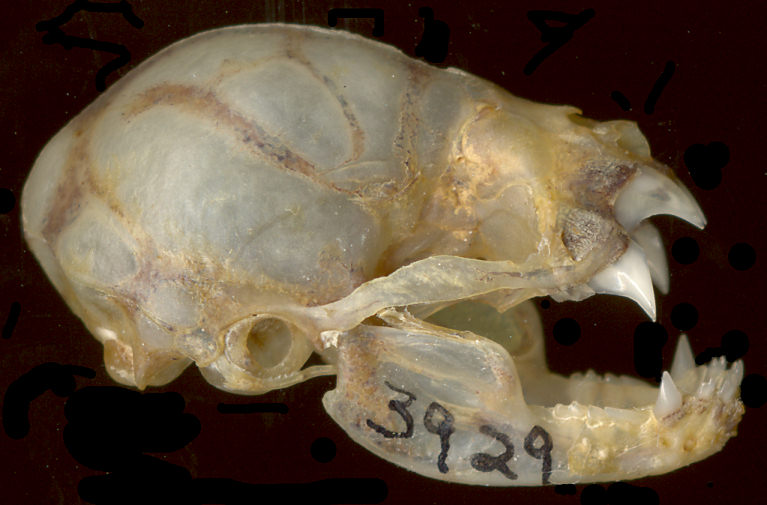Post by OldGreenVulture on Dec 17, 2019 5:17:43 GMT
Common Vampire Bat - Desmodus rotundus.
.jpg/640px-Desmo-boden_(cropped).jpg)
Scientific classification
Kingdom: Animalia
Phylum: Chordata
Class: Mammalia
Order: Chiroptera
Family: Phyllostomidae
Subfamily: Desmodontinae
Genus: Desmodus
Species: Desmodus rotundus
The Common Vampire Bat (Desmodus rotundus) is a species of vampire bat. They have burnt amber colored fur on their backside while soft and velvety light brown fur covers their belly. They have large pointy ears and a flat leaf-shaped nose. Their babies use tiny thumbs in the middle of the wing to cling on the mother’s furry belly. Vampire bats are about 9 cm (3.5 in) long and have a wingspan of 18 cm (7 in). They commonly weigh about 57 grams (2 oz), but that can double after just one feeding.

Feeding
Vampire bats feed on the blood of large birds, cattle, horses, pigs, dogs and many other animals including humans. However, they don’t suck the blood directly from their "victims", they let it flow from the wound first before lapping it up.
The Common Vampire is a highly evolved bat. The front teeth, lips and tongue are highly specialized, with the former used to trim the surrounding fur of the host, acting like scissors. Then a piece of skin is removed by the razor-sharp V-shaped front teeth, much like using a spoon to scoop ice cream out of a cup. During this process the animal's saliva, which contains an anticoagulant, is released and the resulting wound bleeds freely, enabling the vampire to feed using grooves in its lower lip and under its tongue. The grooves form a straw-like structure enabling the bat to suck the blood rather than lapping it.
Distribution

Behavior
The vampire bat is one of the few known bats capable of walking, jumping and hopping. This is accomplished by folding its wings in such a fashion that the animal literally walks on its thumbs. This behavior is important because it permits the bat to stealthily maneuver on the ground and host. Vampires climb to get to places on the host, such as shoulders, underside of the tail and teats and soft tissue near the hoof to get to the unique spot. Often they will return night after night to the same animal (particularly tethered farm animals), so they just have to lift the scab from previous visits to get more blood. It is speculated that before the introduction of domesticated animals, vampires fed upon a wide variety of animals including opossums, armadillos, raccoons, snakes, birds, monkeys, and so forth.
From Carnivora.
carnivora.net/common-vampire-bat-desmodus-rotundus-t2045.html
.jpg/640px-Desmo-boden_(cropped).jpg)
Scientific classification
Kingdom: Animalia
Phylum: Chordata
Class: Mammalia
Order: Chiroptera
Family: Phyllostomidae
Subfamily: Desmodontinae
Genus: Desmodus
Species: Desmodus rotundus
The Common Vampire Bat (Desmodus rotundus) is a species of vampire bat. They have burnt amber colored fur on their backside while soft and velvety light brown fur covers their belly. They have large pointy ears and a flat leaf-shaped nose. Their babies use tiny thumbs in the middle of the wing to cling on the mother’s furry belly. Vampire bats are about 9 cm (3.5 in) long and have a wingspan of 18 cm (7 in). They commonly weigh about 57 grams (2 oz), but that can double after just one feeding.

Feeding
Vampire bats feed on the blood of large birds, cattle, horses, pigs, dogs and many other animals including humans. However, they don’t suck the blood directly from their "victims", they let it flow from the wound first before lapping it up.
The Common Vampire is a highly evolved bat. The front teeth, lips and tongue are highly specialized, with the former used to trim the surrounding fur of the host, acting like scissors. Then a piece of skin is removed by the razor-sharp V-shaped front teeth, much like using a spoon to scoop ice cream out of a cup. During this process the animal's saliva, which contains an anticoagulant, is released and the resulting wound bleeds freely, enabling the vampire to feed using grooves in its lower lip and under its tongue. The grooves form a straw-like structure enabling the bat to suck the blood rather than lapping it.
Distribution

Behavior
The vampire bat is one of the few known bats capable of walking, jumping and hopping. This is accomplished by folding its wings in such a fashion that the animal literally walks on its thumbs. This behavior is important because it permits the bat to stealthily maneuver on the ground and host. Vampires climb to get to places on the host, such as shoulders, underside of the tail and teats and soft tissue near the hoof to get to the unique spot. Often they will return night after night to the same animal (particularly tethered farm animals), so they just have to lift the scab from previous visits to get more blood. It is speculated that before the introduction of domesticated animals, vampires fed upon a wide variety of animals including opossums, armadillos, raccoons, snakes, birds, monkeys, and so forth.
From Carnivora.
carnivora.net/common-vampire-bat-desmodus-rotundus-t2045.html

